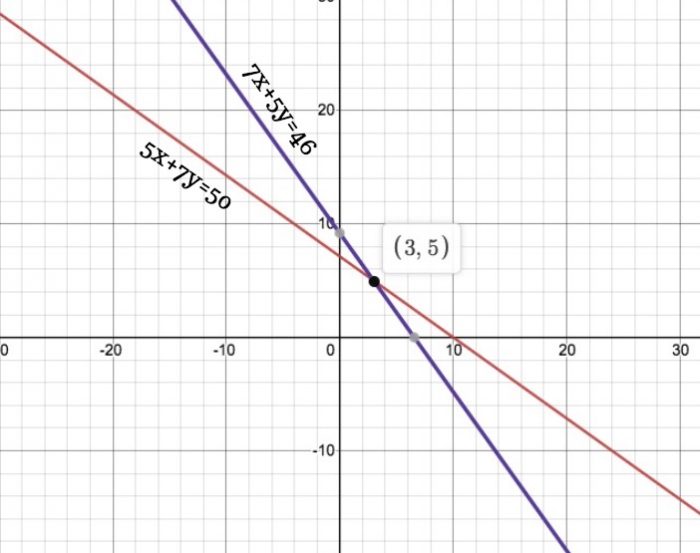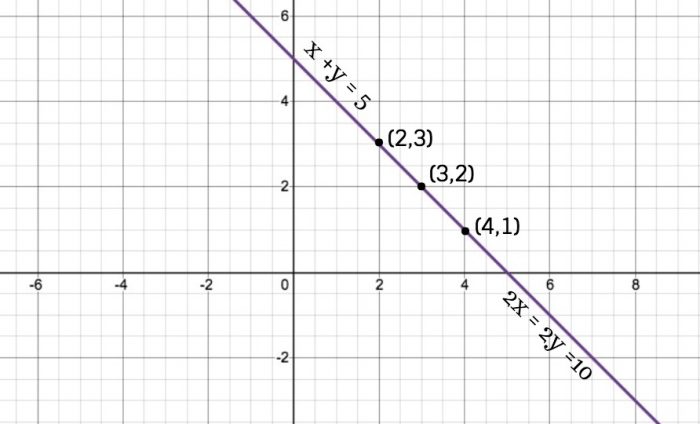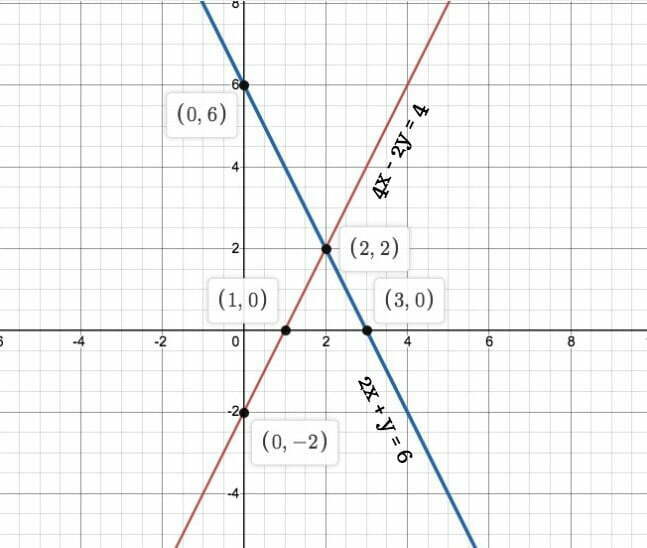NCERT Solutions for Class 10 Maths Chapter 3
Pair of Linear Equations in Two Variables
Exercise 3.2
Page 49
1. Form the pair of linear equations in the following problems, and find their solutions graphically.
(i) 10 students of Class X took part in a Mathematics quiz. If the number of girls is 4 more than the number of boys, find the number of boys and girls who took part in the quiz.
(ii) 5 pencils and 7 pens together cost ₹ 50, whereas 7 pencils and 5 pens together cost ₹ 46. Find the cost of one pencil and that of one pen.
(i) Let there are x number of girls and y number of boys. As per the given question, the algebraic expression can be represented as follows.
x +y = 10
x– y = 4
Now, for x+y = 10 or x = 10−y, the solutions are :-
| x | 5 | 4 | 6 |
| y | 5 | 6 | 4 |
For x – y = 4 or x = 4 + y, the solutions are :-
| x | 4 | 5 | 3 |
| y | 0 | 1 | -1 |
The graphical representation is as follows :-
From the graph, it can be observed that these lines intersect each other at point (7, 3).
Therefore, the number of girls and boys in the class are 7 and 3 respectively.
(ii) Let 1 pencil costs Rs.x and 1 pen costs Rs.y.
According to the question, the algebraic expression cab be represented as;
5x + 7y = 50
7x + 5y = 46
For, 5x + 7y = 50 or x = (50-7y)/5, the solutions are :-
| x | 3 | 10 | -4 |
| y | 5 | 0 | 10 |
For 7x + 5y = 46 or x = (46-5y)/7, the solutions are :-
| x | 8 | 3 | -2 |
| y | -2 | 5 | 12 |
Hence, the graphical representation is as follows :-
From the graph, it is can be seen that the given lines cross each other at point (3, 5).
So, the cost of a pencil is ₹ 3 and cost of a pen is ₹ 5
2. On comparing the ratios a1/a2 , b1/b2 , c1/c2 find out whether the lines representing the following pairs of linear equations intersect at a point, are parallel or coincident:
(i) 5x – 4y + 8 = 0
7x + 6y – 9 = 0
(ii) 9x + 3y + 12 = 0
18x + 6y + 24 = 0
(iii) 6x – 3y + 10 = 0
2x – y + 9 = 0
(i) 5x−4y+8 = 0
7x+6y−9 = 0
Comparing these equations with a1x+b1y+c1 = 0
And a2x+b2y+c2 = 0
We get,
a1 = 5, b1 = -4, c1 = 8
a2 = 7, b2 = 6, c2 = -9
(a1/a2) = 5/7
(b1/b2) = -4/6 = -2/3
(c1/c2) = 8/-9
Since, (a1/a2) ≠ (b1/b2)
So, the pairs of equations given in the question have a unique solution and the lines cross each other at exactly one point.
(ii) 9x + 3y + 12 = 0
18x + 6y + 24 = 0
Comparing these equations with a1x+b1y+c1 = 0
And a2x+b2y+c2 = 0
We get,
a1 = 9, b1 = 3, c1 = 12
a2 = 18, b2 = 6, c2 = 24
(a1/a2) = 9/18 = 1/2
(b1/b2) = 3/6 = 1/2
(c1/c2) = 12/24 = 1/2
Since (a1/a2) = (b1/b2) = (c1/c2)
So, the pairs of equations given in the question have infinite possible solutions and the lines are coincident.
(iii) 6x – 3y + 10 = 0
2x – y + 9 = 0
Comparing these equations with a1x+b1y+c1 = 0
And a2x+b2y+c2 = 0
We get,
a1 = 6, b1 = -3, c1 = 10
a2 = 2, b2 = -1, c2 = 9
(a1/a2) = 6/2 = 3/1
(b1/b2) = -3/-1 = 3/1
(c1/c2) = 10/9
Since (a1/a2) = (b1/b2) ≠ (c1/c2)
So, the pairs of equations given in the question are parallel to each other and the lines never intersect each other at any point and there is no possible solution for the given pair of equations.
3. On comparing the ratio, (a1/a2) , (b1/b2) , (c1/c2) find out whether the following pair of linear equations are consistent, or inconsistent.
(i) 3x + 2y = 5 ; 2x – 3y = 7
(ii) 2x – 3y = 8 ; 4x – 6y = 9
(iii)(3/2)x+(5/3)y = 7; 9x – 10y = 14
(iv) 5x – 3y = 11 ; – 10x + 6y = –22
(v)(4/3)x+2y = 8 ; 2x + 3y = 12
(i) 3x + 2y = 5 or 3x + 2y -5 = 0
and 2x – 3y = 7 or 2x – 3y -7 = 0
Comparing these equations with a1x+b1y+c1 = 0
And a2x+b2y+c2 = 0
We get,
a1 = 3, b1 = 2, c1 = -5
a2 = 2, b2 = -3, c2 = -7
(a1/a2) = 3/2
(b1/b2) = 2/-3
(c1/c2) = -5/-7 = 5/7
Since, (a1/a2) ≠ (b1/b2)
So, the given equations intersect each other at one point and they have only one possible solution. The equations are consistent.
(ii) 2x – 3y = 8 and 4x – 6y = 9
∴ a1 = 2, b1 = -3, c1 = -8
a2 = 4, b2 = -6, c2 = -9
(a1/a2) = 2/4 = 1/2
(b1/b2) = -3/-6 = 1/2
(c1/c2) = -8/-9 = 8/9
Since , (a1/a2) = (b1/b2) ≠ (c1/c2)
So, the equations are parallel to each other and they have no possible solution. Hence, the equations are inconsistent.
(iii) (3/2)x + (5/3)y = 7 and 9x – 10y = 14
∴ a1 = 3/2, b1 = 5/3, c1 = -7
a2 = 9, b2 = -10, c2 = -14
(a1/a2) = 3/(2×9) = 1/6
(b1/b2) = 5/(3× -10)= -1/6
(c1/c2) = -7/-14 = 1/2
Since, (a1/a2) ≠ (b1/b2)
So, the equations are intersecting each other at one point and they have only one possible solution. Hence, the equations are consistent.
(iv) 5x – 3y = 11 and – 10x + 6y = –22
∴ a1 = 5, b1 = -3, c1 = -11
a2 = -10, b2 = 6, c2 = 22
(a1/a2) = 5/(-10) = -5/10 = -1/2
(b1/b2) = -3/6 = -1/2
(c1/c2) = -11/22 = -1/2
Since (a1/a2) = (b1/b2) = (c1/c2)
These linear equations are coincident lines and have infinite number of possible solutions. Hence, the equations are consistent.
(v) (4/3)x +2y = 8 and 2x + 3y = 12
a1 = 4/3 , b1= 2 , c1 = -8
a2 = 2, b2 = 3 , c2 = -12
(a1/a2) = 4/(3×2)= 4/6 = 2/3
(b1/b2) = 2/3
(c1/c2) = -8/-12 = 2/3
Since (a1/a2) = (b1/b2) = (c1/c2)
These linear equations are coincident lines and have infinite number of possible solutions. Hence, the equations are consistent.
4. Which of the following pairs of linear equations are consistent/inconsistent? If consistent, obtain the solution graphically:
(i) x + y = 5, 2x + 2y = 10
(ii) x – y = 8, 3x – 3y = 16
(iii) 2x + y – 6 = 0, 4x – 2y – 4 = 0
(iv) 2x – 2y – 2 = 0, 4x – 4y – 5 = 0
(i) x + y = 5 and 2x + 2y = 10
(a1/a2) = 1/2
(b1/b2) = 1/2
(c1/c2) = 1/2
Since (a1/a2) = (b1/b2) = (c1/c2)
∴ The equations are coincident and they have infinite number of possible solutions.
So, the equations are consistent.
For, x + y = 5 or x = 5 – y
| x | 4 | 3 | 2 |
| y | 1 | 2 | 3 |
For 2x + 2y = 10 or x = (10-2y)/2
| x | 4 | 3 | 2 |
| y | 1 | 2 | 3 |
So, the equations are represented in graphs as follows:
From the figure, we can see, that the lines are overlapping each other.
Therefore, the equations have infinite possible solutions.
(ii) Given, x – y = 8 and 3x – 3y = 16
(a1/a2) = 1/3
(b1/b2) = -1/-3 = 1/3
(c1/c2) = 8/16 = 1/2
Since, (a1/a2) = (b1/b2) ≠ (c1/c2)
The equations are parallel to each other and have no solutions. Hence, the pair of linear equations is inconsistent.
(iii) Given, 2x + y – 6 = 0 and 4x – 2y – 4 = 0
(a1/a2) = 2/4 = ½
(b1/b2) = 1/-2
(c1/c2) = -6/-4 = 3/2
Since, (a1/a2) ≠ (b1/b2)
The given linear equations are intersecting each other at one point and have only one solution. Hence, the pair of linear equations is consistent.
Now, for 2x + y – 6 = 0 or y = 6 – 2x
| x | 0 | 1 | 2 |
| y | 0 | 4 | 2 |
and for 4x – 2y – 4 = 0 or y = (4x-4)/2
| x | 1 | 2 | 3 |
| y | 0 | 2 | 4 |
So, the equations are represented in graphs as follows :-
From the graph, it can be seen that these lines are intersecting each other at only one point,(2,2).
(iv) Given, 2x – 2y – 2 = 0 and 4x – 4y – 5 = 0
(a1/a2) = 2/4 = ½
(b1/b2) = -2/-4 = 1/2
(c1/c2) = 2/5
Since, a1/a2 = b1/b2 ≠ c1/c2
Thus, these linear equations have parallel and have no possible solutions. Hence, the pair of linear equations are inconsistent.
5. Half the perimeter of a rectangular garden, whose length is 4 m more than its width, is 36 m. Find the dimensions of the garden.
Let length of garden = x m and width of garden = y m
Perimeter of rectangular garden = 2(x + y)
According to the question
1st Condition :
2(+)/2 = 36
⇒ x + y = 36 …(i)
2nd Condition :
x = y + 4
⇒ x -y = 4 … (ii)
Adding equation (i) and (ii), we get
2x = 40 ⇒ x = 20
Putting x = 20 in equation (i), we get
20 + y = 36
y = 16
Hence, dimensions of the garden are 20 m and 16 m.
6. Given the linear equation 2x + 3y – 8 = 0, write another linear equation in two variables such that the geometrical representation of the pair so formed is:
(i) Intersecting lines
(ii) Parallel lines
(iii) Coincident lines
(i) Given the linear equation 2x + 3y – 8 = 0.
To find another linear equation in two variables such that the geometrical representation of the pair so formed is intersecting lines, it should satisfy below condition;
(a1/a2) ≠ (b1/b2)
Thus, another equation could be 2x +4y -6 = 0, such that;
(a1/a2) = 2/2 = 1 and (b1/b2) = 3/4
Clearly, you can see another equation satisfies the condition.
(ii) Given the linear equation 2x + 3y – 8 = 0.
To find another linear equation in two variables such that the geometrical representation of the pair so formed is parallel lines, it should satisfy below condition;
(a1/a2) = (b1/b2) ≠ (c1/c2)
Thus, another equation could be 4x + 6y − 8 = 0, such that;
(a1/a2) = 2/4 = 1/2
(b1/b2) = 3/6= 1/2
(c1/c2) = -8/-8 = 1
Clearly, you can see another equation satisfies the condition.
(iii) Given the linear equation 2x + 3y – 8 = 0.
To find another linear equation in two variables such that the geometrical representation of the pair so formed is coincident lines, it should satisfy below condition;
(a1/a2) = (b1/b2) = (c1/c2)
Thus, another equation could be 6x + 9y − 24 = 0, such that;
(a1/a2) = 2/6 = 1/3 ,(b1/b2) = 3/9 = 1/3, (c1/c2) = -8/-24 = 1/3
Clearly, you can see another equation satisfies the condition.
7. Draw the graphs of the equations x – y + 1 = 0 and 3x + 2y – 12 = 0. Determine the coordinates of the vertices of the triangle formed by these lines and the x-axis, and shade the triangular region.
Given, the equations for graphs are x – y + 1 = 0 and 3x + 2y – 12 = 0.
For, x – y + 1 = 0 or x = 1+y
Given, the equations for graphs are x – y + 1 = 0 and 3x + 2y – 12 = 0.
For, x – y + 1 = 0 or x = 1+y
| x | 0 | 1 | 2 |
| y | 1 | 2 | 3c |
For, 3x + 2y – 12 = 0 or x = (12-2y)/3
| x | 4 | 2 | 0 |
| y | 0 | 3 | 6 |
Hence, the graphical representation of these equations is as follows :-
From the figure, it can be seen that these lines are intersecting each other at point (2, 3) and x-axis at (−1, 0) and (4, 0).
Therefore, the vertices of the triangle are (2, 3), (−1, 0), and (4, 0).





Leave a Reply